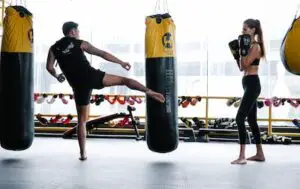Taekwondo is a martial art that originated in Korea in the 1940s. It is an Olympic sport since the 2000 Sydney Games. The sport has two disciplines: sparring and poomsae. In sparring, two players fight against each other, while in poomsae, they perform a series of predetermined movements. In this article, we will focus on taekwondo sparring, and how the scoring system works in the Olympics.
How is taekwondo sparring played in the Olympics?
In taekwondo sparring, two athletes fight against each other inside a ring. They wear protective gear, including a helmet, gloves, chest protector, arm protectors, and shin guards. The objective is to score as many points as possible by hitting the opponent’s trunk protector or headgear with a valid technique.
The match consists of three rounds of two minutes each, with a one-minute rest in between. If the score is tied after the third round, an additional round is played to determine the winner. If the score is still tied after the additional round, the referee declares the winner based on the superiority criteria, which we will discuss later.
How are points scored in taekwondo sparring?
Points are scored when a player lands a valid technique on the opponent’s trunk protector or headgear. Valid techniques are kicks and punches executed with the correct technique, distance, power, and control. Each valid technique scores one point, while a valid turning or spinning kick scores two points.
The referee, who stands outside the ring, observes the match and awards points based on the following criteria:
– Accuracy: The technique must hit the trunk protector or headgear cleanly without touching any other part of the body or the floor.
– Force: The technique must be powerful enough to cause an impact on the protector or headgear.
– Control: The technique must be executed with control and precision, without losing balance or falling down.
– Distance: The technique must be performed within the correct distance, which varies depending on the technique and the target area.
– Validity: The technique must be executed according to the rules and regulations of taekwondo sparring.
How is the winner determined in taekwondo sparring?
The winner is the player who scores the most points at the end of the match or after the additional round, if necessary. If the score is tied, the referee declares the winner based on the following superiority criteria:
– Number of valid points: The player with the most valid points wins.
– Number of gamjeom: Gamjeom is a penalty awarded to a player who violates the rules or receives a warning. If both players have the same number of valid points, the player with fewer gamjeom wins.
– Number of kyonggo: Kyonggo is a warning given to a player for minor infrctions. If both players have the same number of valid points and gamjeom, the player with fewer kyonggo wins.
– Number of knockdowns: A knockdown occurs when a player falls down due to an opponent’s valid technique. The player who knocks down the opponent wins, even if the opponent has more valid points.
– Priority: If all the criteria are still tied, the referee awards priority to one player based on a random draw. The player with priority wins if the match is still tied after an additional round.
How do the electronic protectors work in taekwondo sparring?
Electronic protectors, also known as PSS (Protective Scoring System), are used in taekwondo sparring to eliminate human error and ensure fair and accurate scoring. They consist of a trunk protector and headgear with sensors that detect the impact of a valid technique. When a player lands a valid technique on the protector or headgear, the sensor sends a signal to a computer, which registers the point.
The PSS also has a hogu impact sensor, which detects the power of the kick or punch. If the impact is not strong enough, the computer does not register the point. The PSS system has been used in the Olympics since 2008 to improve the quality and transparency of taekwondo sparring.
How do the athletes prepare for taekwondo sparring in the Olympics?
Taekwondo athletes must undergo rigorous training to prepare for the Olympics. They practice various techniques, including kicks, punches, blocks, sweeps, and throws. They also engage in physical conditioning, such as strength training, endurance training, and flexibility training.
In addition, taekwondo athletes must develop their mental and emotional skills, such as focus, concentration, confidence, and resilience. They must also study their opponents’ strengths and weaknesses to develop a game plan and strategy for each match.
Who are the best taekwondo athletes in the Olympics?
There have been many outstanding taekwondo athletes in the Olympics, who have won numerous medals and set new records. Some of the most notable ones include:
– Jingyu Wu: She is a Chinese taekwondo athlete who has won two gold medals and one bronze medal in the Olympics. She is known for her fast and accurate kicks and her ability to control the match.
– Servet Tazegul: He is a Turkish taekwondo athlete who has won two gold medals in the Olympics. He is known for his powerful and dynamic kicks and his strategic mind.
– Jade Jones: She is a British taekwondo athlete who has won two gold medals in the Olympics. She is known for her aggressive and fearless style and her ability to adapt to any opponent.
– Steven Lopez: He is an American taekwondo athlete who has won two gold medals and one bronze medal in the Olympics. He is known for his precision and technique and his longevity in the sport.
– Hadi Saei: He is an Iranian taekwondo athlete who has won two gold medals and one bronze medal in the Olympics. He is known for his speed and agility and his ability to surprise his opponents.
Conclusion
Taekwondo sparring is a fascinating and dynamic sport that requires a combination of physical, mental, and emotional skills. The scoring system used in the Olympics ensures that the matches are fair and transparent, and the electronic protectors eliminate human error and bias. The best taekwondo athletes in the world have demonstrated their excellence in the Olympics, inspiring millions of people to practice the sport and embrace its values of respect, discipline, and perseverance.





